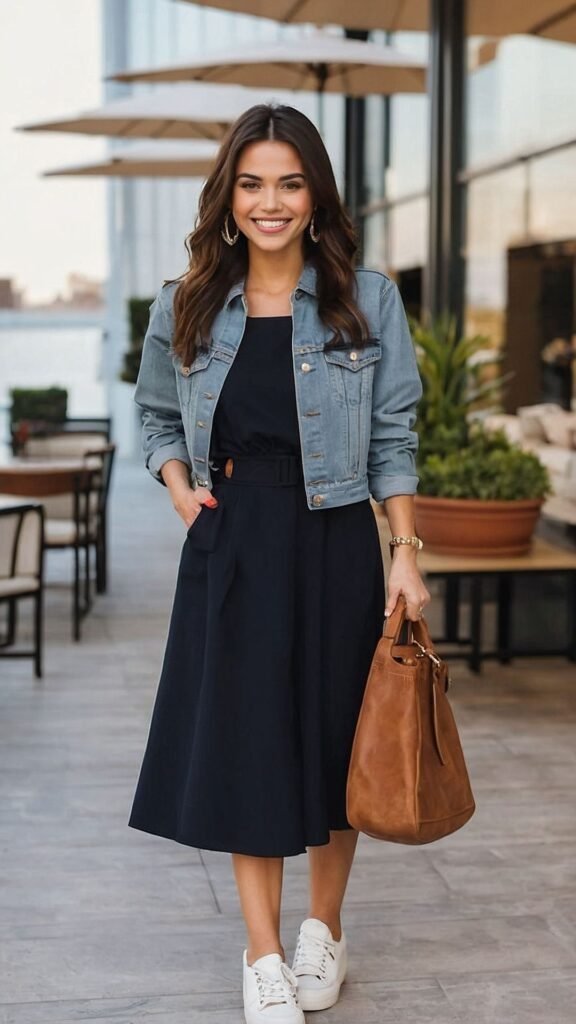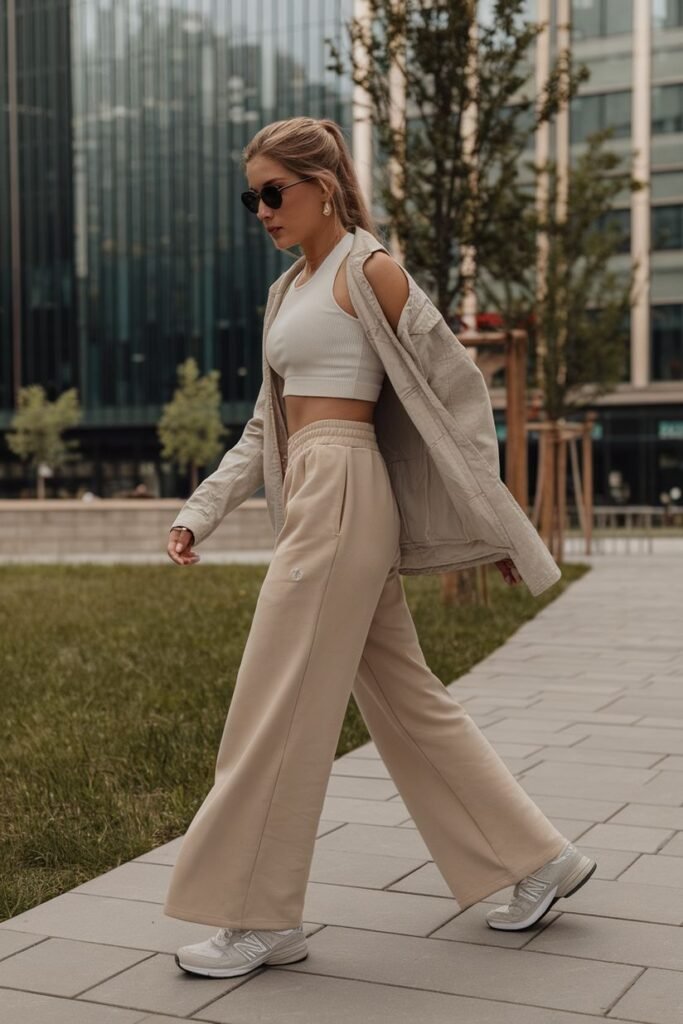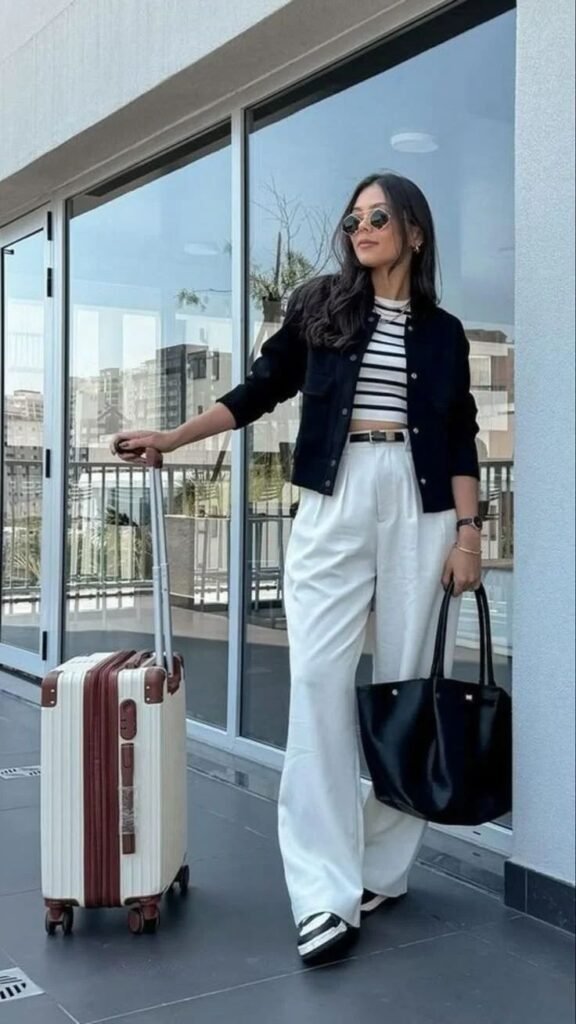Introduction
In today’s fast-paced world, busy professionals often struggle to balance style with comfort. Long workdays, commuting, back-to-back meetings, and occasional after-work events demand clothing that is both presentable and practical. While fashion trends often emphasize aesthetics over functionality, Mixing Comfort is essential for maintaining confidence, focus, and productivity throughout the day. The challenge lies in finding wardrobe solutions that are stylish yet wearable, versatile, and adaptable to different work environments.
The importance of mixing Mixing Comfort with style extends beyond appearance—it impacts mood, energy levels, and even professional performance. Wearing uncomfortable clothing or shoes can distract from tasks and reduce confidence during important meetings or presentations. Conversely, prioritizing comfort doesn’t mean sacrificing style; with the right approach, professionals can cultivate a wardrobe that reflects personal taste while supporting efficiency and ease.
This article explores practical fashion strategies, tips, and hacks tailored for busy professionals. It covers wardrobe essentials, smart styling techniques, Mixing Comfort fabrics, footwear solutions, accessories, and the art of mixing and matching. By implementing these strategies, professionals can navigate their workday confidently, seamlessly transition between different settings, and maintain a polished, stylish appearance without compromising comfort.

Understanding the Balance: Style vs. Comfort
For busy professionals, achieving a balance between style and Mixing Comfort is essential for confidence, productivity, and overall well-being. Style often focuses on aesthetics, trends, and personal expression, while Mixing Comfort emphasizes ease of movement, fit, and functionality. Many professionals mistakenly believe they must choose one over the other, but thoughtful wardrobe planning can merge the two seamlessly.
Key elements in finding this balance include fit and silhouette, which ensure clothing looks polished without restricting movement, and fabric choice, such as breathable cotton, linen, or blends with spandex that provide stretch and flexibility. Layering is another important factor, allowing adaptation to fluctuating temperatures or transitions from meetings to after-work events. Footwear also plays a crucial role: stylish shoes should provide support and cushioning to prevent fatigue during long workdays.
Additionally, prioritizing functional wardrobe staples over purely trendy items ensures versatility and practicality. Blazers, tailored trousers, and shift dresses, for example, can be styled in multiple ways while remaining comfortable. Understanding these aspects enables professionals to make informed clothing choices that harmonize aesthetics with functionality, allowing them to look polished, feel Mixing Comfort, and navigate busy days with ease.
Achieving a balance between style and comfort requires understanding the elements that contribute to both. Style is often about aesthetics, trends, and personal expression, while Mixing Comfort focuses on functionality, fit, and ease of movement. Many professionals mistakenly believe they must choose one over the other, but thoughtful wardrobe planning can merge the two seamlessly.
Key Considerations:
- Fit and Silhouette: Clothing that fits well enhances style without sacrificing Mixing Comfort. Tailored but flexible cuts allow movement and reduce discomfort.
- Fabric Choice: Natural fabrics like cotton, linen, and wool breathe well and reduce irritation, while blends with spandex or elastane offer stretch and flexibility.
- Layering: Smart layering enables adaptability for fluctuating temperatures, long commutes, or transitioning from work to after-hours events.
- Footwear: Shoes should complement outfits aesthetically while providing arch support and cushioning. The right footwear prevents fatigue and posture issues.
- Functionality vs. Trendiness: Prioritize functional staples, like blazers or trousers, that can be styled in multiple ways rather than investing in items that are purely trendy but impractical.
Understanding these aspects allows professionals to make informed clothing choices that harmonize Mixing Comfort with style, leading to both productivity and confidence in professional settings.
Wardrobe Essentials for Busy Professionals
Building a wardrobe that balances style and Mixing Comfort begins with investing in versatile essentials. These foundational pieces allow busy professionals to create polished outfits quickly while ensuring all-day ease.
Tops and Shirts: Breathable button-down shirts, soft blouses, and lightweight knitwear are wardrobe staples. Neutral colors and subtle patterns provide versatility, while fabrics with slight stretch allow Mixing Comfort without compromising professionalism.
Bottoms: Tailored trousers with a flexible waistband, chic A-line or pencil skirts, and dark-wash slim-fit jeans are ideal for daily wear. These pieces can be dressed up or down, making them suitable for various office environments.
Dresses: Shift and wrap dresses offer effortless style and Mixing Comfort, providing polished silhouettes that accommodate long workdays.
Outerwear: Structured yet flexible blazers and lightweight jackets help navigate changing office temperatures while maintaining a professional appearance.
Accessories and Bags: Minimalist jewelry adds sophistication without distraction, and functional bags, such as tote bags or backpacks with padded straps, ensure Mixing Comfort during commutes.
By focusing on these wardrobe essentials, professionals can mix and match outfits efficiently, maintaining a stylish and Mixing Comfort look every day without spending excessive time or effort on outfit planning.
Creating a wardrobe that combines Mixing Comfort and style starts with investing in key essentials that are versatile, durable, and timeless.
Tops and Shirts
- Button-down shirts: Opt for breathable fabrics with slight stretch. Neutral colors and subtle patterns are easy to mix and match.
- Blouses and tunics: Flowy designs in soft fabrics maintain professionalism while ensuring ease of movement.
- Knitwear and layering pieces: Lightweight sweaters or cardigans provide warmth without restricting mobility.
Bottoms
- Tailored trousers: Choose mid-rise or elastic-waist designs for Mixing Comfort without compromising sophistication.
- Chic skirts: Pencil skirts with stretch fabric or A-line skirts balance style with flexibility.
- Versatile jeans: Dark-wash, slim-fit jeans can be paired with blazers for business-casual settings.
Outerwear
- Blazers: Structured yet flexible blazers elevate any outfit. Stretch blends enhance Mixing Comfort.
- Light jackets and coats: Functional outerwear accommodates changing weather without affecting style.
Dresses
- Shift dresses: Offer a polished look and Mixing Comfort for long workdays.
- Wrap dresses: Adjustable fits provide ease while flattering different body types.
Accessories and Bags
- Minimal jewelry: Adds sophistication without Mixing Comfort.
- Functional bags: Backpacks or tote bags with padded straps distribute weight evenly, reducing strain.
Investing in these wardrobe essentials ensures professionals have a foundation of versatile pieces that can be mixed and matched daily for Mixing Comfort, style, and practicality.

Fabrics That Combine Comfort and Style
Choosing the right fabrics is crucial for balancing Mixing Comfort and style in a professional wardrobe. The right material not only feels good against the skin but also maintains shape, breathability, and a polished appearance throughout the day.
Cotton is a classic choice, offering softness, breathability, and versatility. Cotton shirts, blouses, and dresses are Mixing Comfort for long workdays while remaining professional. Linen provides lightweight and airy Mixing Comfort, ideal for warmer climates, though pairing it with wrinkle-resistant blends ensures a neat look. Wool and cashmere are perfect for cooler seasons, offering warmth and elegance; blended options with a small amount of stretch enhance mobility.
Fabrics with spandex or elastane provide flexibility and stretch without compromising fit, making them excellent for trousers, skirts, and tailored tops. Silk and satin alternatives bring a smooth, luxurious texture to blouses and dresses, combining elegance with comfort.
By selecting fabrics thoughtfully, professionals can ensure all-day wearability while maintaining a sophisticated appearance. Understanding the qualities of each material allows for informed choices that make balancing style and Mixing Comfort effortless, supporting both confidence and productivity in a busy work environment.
Fabric choice significantly impacts both Mixing Comfort and appearance. Selecting the right materials ensures that clothing feels good on the skin, allows breathability, and maintains shape throughout the day.
- Cotton: Breathable, soft, and easy to style. Ideal for shirts, dresses, and casual blazers.
- Linen: Perfect for summer or warm climates. Lightweight and airy, though prone to wrinkles—pair with wrinkle-resistant blends for professional settings.
- Wool and Cashmere: Soft, insulating fabrics for colder months. Stretch blends prevent restriction and maintain professional appearance.
- Spandex/Elastane blends: Provide flexibility and stretch without compromising fit. Useful in trousers, skirts, and tailored tops.
- Silk and satin alternatives: Smooth textures offer elegance and Mixing Comfort for blouses or office dresses.
Knowing which fabrics balance Mixing Comfort with style allows professionals to select garments that support all-day wearability while retaining a polished look.
Footwear Solutions for Busy Professionals
Footwear plays a crucial role in balancing style and Mixing Comfort for busy professionals. The right shoes not only complete an outfit but also support long hours of standing, walking, and commuting.
Loafers are a versatile option, offering a polished look while providing comfort and ease of wear. They are ideal for meetings and office settings where professional appearance matters. Block heels give elevation without the discomfort of stilettos, making them suitable for long workdays. Ballet flats combine elegance with practicality, perfect for quick commutes and casual office environments.
For smart-casual or more relaxed offices, fashionable sneakers can be paired with tailored trousers or dresses to maintain a professional yet comfortable appearance. Caring for footwear is essential—using cushioned insoles, breathable materials, and anti-slip soles prevents fatigue, improves posture, and ensures durability.
Additionally, carrying a second pair of shoes, such as flats or sneakers, allows for seamless transitions from commuting to office hours. By choosing versatile, supportive, and stylish footwear, professionals can maintain comfort throughout the day without compromising their polished, professional image.
Shoes can make or break an outfit and greatly impact comfort throughout a busy day. Choosing the right footwear involves considering support, style, and versatility.
- Loafers: Comfortable, professional, and easy to slip on; suitable for long days of standing or walking.
- Block heels: Provide elevation without discomfort compared to stilettos.
- Ballet flats: Classic and comfortable, ideal for commuting or casual office settings.
- Sneakers: Smart-casual sneakers can pair with tailored outfits for office-appropriate comfort.
- Caring for Footwear: Cushioned insoles, anti-slip soles, and breathable materials prevent fatigue and maintain style.
Selecting versatile shoes that align with the wardrobe ensures professionals can move confidently without compromising aesthetics or comfort.
Styling Techniques for Comfort and Elegance
Combining comfort and elegance requires thoughtful styling techniques that enhance both functionality and appearance. Layering is a key strategy: lightweight cardigans under structured blazers or fitted vests over blouses provide warmth and a polished look while allowing flexibility throughout the day.
Mix and match approaches enable professionals to create multiple outfits from a few essentials. Neutral-colored basics can be paired with statement pieces such as patterned scarves, bold jewelry, or colorful accessories to add personality without sacrificing comfort.
Accessorizing smartly enhances elegance while maintaining practicality. Minimalist jewelry reduces discomfort during long work hours, functional belts improve fit and silhouette, and scarves or wraps add style and warmth when needed.
For office days with a smart-casual dress code, professionals can incorporate tailored jeans, knit tops, or flexible skirts. Pairing these with blazers, loafers, or low heels keeps the outfit professional yet comfortable.
Finally, focusing on proportion and fit ensures that clothing flatters the body while allowing ease of movement. By applying these styling techniques, busy professionals can maintain a chic, sophisticated appearance that feels comfortable, supports confidence, and seamlessly adapts to diverse daily demands.
Layering
Layering allows flexibility for temperature changes while maintaining a stylish appearance. Pair lightweight cardigans under structured blazers, or wear a fitted vest over a blouse for a polished look.
Mix and Match
Use neutral colors as a base, and add statement pieces like patterned scarves or bold jewelry for style without sacrificing comfort.
Accessories
- Minimalist jewelry: Reduces discomfort and complements professional attire.
- Functional belts: Enhance fit and silhouette.
- Scarves and wraps: Add elegance and warmth when needed.
Smart Casual Options
Incorporate casual pieces like tailored jeans or comfortable knit tops for days with lighter dress codes while maintaining professionalism through structured layering and accessories.

Daily Fashion Hacks for Busy Professionals
Busy professionals can save time, maintain style, and ensure comfort by adopting simple daily fashion hacks. Planning outfits ahead of time is one of the most effective strategies. Setting aside a few minutes each evening to choose the next day’s attire reduces morning stress and prevents last-minute mismatches.
Wrinkle-free garments or quick-iron fabrics save time and maintain a polished look throughout the day. Incorporating multi-functional pieces, such as dresses or blazers that transition easily from office meetings to after-work events, maximizes versatility and reduces wardrobe clutter.
Mixing textures and layering adds visual interest without bulk, allowing simple outfits to appear stylish and well-thought-out. Carrying a change of shoes—for instance, swapping flats for heels after commuting—ensures comfort without compromising professionalism.
Minimal accessories like watches, scarves, or belts enhance outfits without adding discomfort, while neutral color palettes make mixing and matching effortless.
By implementing these practical hacks, professionals can navigate hectic schedules with confidence, ensuring their wardrobe remains functional, stylish, and comfortable. Small adjustments and strategic planning can dramatically improve daily appearance, comfort, and overall confidence, making it easier to maintain a polished and professional image every day.
- Plan outfits ahead: Pre-selecting clothes reduces morning stress.
- Use wrinkle-free garments: Saves time on ironing.
- Mix textures: Adds visual interest without bulk.
- Carry a change of shoes: Transition from commuting to office seamlessly.
- Invest in multi-functional pieces: Dresses or jackets that work for meetings and after-hours events.
Real-Life Examples and Case Studies
Several busy professionals have successfully balanced comfort and style through thoughtful wardrobe choices and practical strategies. Emma, a corporate executive, combines tailored stretch trousers with silk blouses and block heels. This combination allows her to move comfortably during long meetings while maintaining a polished, professional appearance.
Ravi, a startup professional, uses smart-casual layering with loafers, knit tops, and lightweight blazers. His versatile outfits enable him to transition effortlessly between client meetings and informal team sessions, staying stylish without sacrificing comfort.
Sofia, a remote worker who occasionally attends client presentations, relies on soft knit tops paired with midi skirts and supportive flats. This approach ensures she looks professional on video calls while remaining comfortable for extended periods at her desk.
These examples demonstrate that integrating versatile wardrobe essentials, investing in quality fabrics, and using smart styling techniques can help professionals navigate demanding workdays efficiently. By prioritizing both style and comfort, these individuals maintain confidence, energy, and a polished appearance throughout their daily routines.
Real-life case studies highlight that achieving this balance is not only possible but also practical, showing that intentional planning and thoughtful choices make fashion functional, empowering, and suitable for modern professional life.
- Emma, a corporate executive: Combines tailored stretch trousers with silk blouses and block heels for all-day comfort.
- Ravi, a startup professional: Uses smart-casual layering with loafers and lightweight blazers to balance style and flexibility.
- Sofia, a remote worker with client meetings: Opts for soft knit tops paired with midi skirts and supportive flats for a polished look without discomfort.
These examples show that intentional wardrobe planning and practical styling make it possible to remain fashionable without sacrificing comfort.
Conclusion
Balancing comfort and style is essential for busy professionals who navigate demanding workdays. By investing in versatile wardrobe essentials, selecting quality fabrics, and incorporating practical styling techniques, professionals can maintain a polished, confident appearance without sacrificing comfort. Footwear, layering, accessories, and daily fashion hacks further enhance ease and efficiency. Real-life examples demonstrate that thoughtful planning and intentional choices make it possible to look stylish while staying comfortable. Ultimately, blending functionality with elegance empowers professionals to focus on their work, transition seamlessly between settings, and approach each day with confidence and poise.
Mixing comfort and style is achievable for busy professionals through thoughtful wardrobe selection, fabric choice, and practical styling techniques. By investing in versatile essentials, prioritizing comfortable fabrics, selecting supportive footwear, and using smart styling methods, professionals can navigate demanding workdays confidently and effortlessly. Fashion no longer has to be sacrificed for comfort; with the right strategies, style becomes functional, empowering, and sustainable.
Related Post: 7 Top Causes of Google Maps Not Working and How to Fix Them

